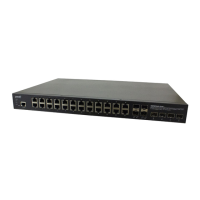Lantronix SISPM1040-xxxx-L3 Web User Guide
33856 Rev. A https://www.lantronix.com/ 54
Port Management > Energy Efficient Ethernet
This page lets you configure the port power savings features.
EEE is a power saving option that reduces the power usage when there is low or no traffic utilization.
EEE works by powering down circuits when there is no traffic. When a port gets data to be transmitted all circuits
are powered up. The time it takes to power up the circuits is named wakeup time. The default wakeup time is 17
us for 1Gbit links and 30 us for other link speeds. EEE devices must agree upon the value of the wakeup time in
order to make sure that both the receiving and transmitting device has all circuits powered up when traffic is
transmitted. The devices can exchange wakeup time information using the LLDP protocol.
EEE works for ports in auto-negotiation mode, where the port is negotiated to either 1G or 100 Mbit full duplex
mode. For ports that are not EEE-capable the corresponding EEE checkboxes are grayed out and thus
impossible to enable EEE for.
When a port is powered down for saving power, outgoing traffic is stored in a buffer until the port is powered up
again. Because there is some overhead in turning the port down and up, more power can be saved if the traffic
can be buffered until a large burst of traffic can be transmitted. Buffering traffic will add some latency to the traffic.
Port: The switch port number of the logical port.
Configure: Controls whether EEE is enabled for this switch port.
Buttons
Apply: Click to save changes.
Reset: Click to undo any changes made locally and revert to previously saved values.

